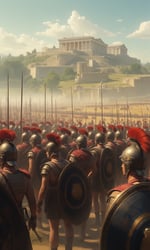Here's an expanded description of the ancient Greek war scene in English, incorporating additional details:
Imagine a pivotal battle in the Greco-Persian Wars of the 5th century BC, where an Athenian-led coalition of Greek city-states clashed with the mighty Persian Empire. The stage is set on a sun-drenched plain, with scattered small hills and a thin layer of mist hanging low over the landscape.
In this epic confrontation, the Greek phalanx formation stands as an impenetrable wall against the charging Persian cavalry. Each Athenian hoplite (infantryman) is armed to the teeth with gleaming bronze armor, sporting distinctive Corinthian helmets adorned with red horsehair plumes. Their long pikes (doru), measuring approximately 8 feet in length, stand vertically at attention, ready to unleash a deadly hail of thrusts.
The phalanx formation is densely packed and impenetrable, with shields overlapping like the scales of a mythical dragon. These shields bear the emblem of their city-state: a proud golden owl against a deep blue background – an enduring symbol of Athenian wisdom and martial prowess.
As the enemy cavalry approaches, the faces of the Greek warriors set in determined expressions, bracing for impact. The air is heavy with tension, thickening the already misty atmosphere. In the foreground, one hoplite stands at the forefront of this unyielding line, his eyes fixed intently on the approaching horde as he grips his shield and pike with battle-hardened hands.
The backdrop of the Athenian Acropolis rises majestically in the distance, its marble structures glistening in the sunlight like beacons of civilization. This ancient citadel stands as a testament to Greek ingenuity and culture, starkly contrasting with the brutal reality of war unfolding on the plains below.
As the Persian cavalry charges forward with thundering hooves and cries of "For the King!", the very earth seems to tremble beneath their feet. The clash of steel against bronze resounds through the misty air, accompanied by the eerie screams of horses and men alike.
This pivotal moment in history captures the essence of ancient warfare – a dance of death between heavily armored infantry and lightning-fast cavalry, with the fate of empires hanging precariously in the balance. The phalanx formation, once considered impenetrable, is about to face its ultimate test against the sheer might of the Persian Empire.
The outcome hangs uncertain, leaving us wondering if this will be a day etched into history as a glorious Greek victory or a crushing defeat at the hands of their Eastern foes. Will the discipline and strategy of the phalanx prove enough to withstand the waves of Persian horsemen, or will the numerical superiority of the enemy break through this seemingly impenetrable line? The battle rages on, with every moment holding the potential to reshape the course of ancient history.
This vivid scene brings to life the intensity and drama of warfare in ancient Greece, showcasing both the technological prowess and human resilience that characterized these epic conflicts. As we gaze upon this frozen moment in time, we're reminded of the enduring legacy left by these ancient warriors – a testament to courage, strategy, and the unyielding spirit of a people determined to defend their city-states against all odds.

